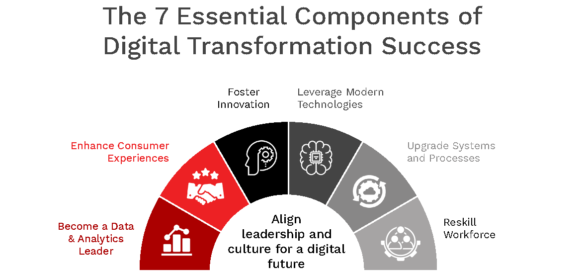Top Digital Banking Transformation Trends for 2021

Despite the pandemic being an everyday reality for every person and business,
organizations can not use this as an excuse to not push forward even further.
New initiatives must be prioritized that can leverage data and analytics to
improve the customer experience. Digital engagement must be improved, focusing
on simplicity and speed far beyond what is currently provided. And, financial
institutions must optimize the use of technology that is already in place.
Every bank and credit union must embrace the digital banking transformation
trends that are forthcoming in 2021, doubling down on the commitment to
improving digital customer experiences as well as the internal processes,
infrastructure, products and personnel that will provide the foundation for
future competitiveness. ... At a time when most financial institutions are
concerned about the prospects of loan losses and the shrinking of revenues in
a post-pandemic economy, the focus on automation and robotics seems natural.
Robotic Process Automation (RPA) can increase efficiency by providing a
cost-effective substitute to human resources both in-house and outsourced.
While still in its infancy, RPA provides the benefits of cost reduction.
increased efficiency, enhanced accuracy, improved customer experiences, and
seamless flexibility.
Digital transformation: 3 things your organization can't afford to overlook

Legal costs are soaring for companies, even if they have their own internal
counsel. An eDiscovery system, whether on premises or in the cloud, is going
to need access to internal company documents, some of them many years
old. eDiscovery systems are designed to code and reference documents for
legal use. These legal search criteria will differ from the user-specified
search criteria that finance, purchasing, and other business departments
initially load into your document management system for their own search
purposes. Being able to easily upload documents into an eDiscovery engine when
you need to can potentially save your company hundreds of thousands of dollars
in document legal discovery that would otherwise be manual and costly.
Minimally, you should ensure that the document management system you use can
easily interface with eDiscovery systems. One area in which paper documents
have been getting digitized is medical records. This happens in a desire to
rid offices of paper, but also when company acquisitions are made and
disparate medical systems (and their documentation) need to be blended.
Willyama's role in helping Indigenous Australians secure a career in cybersecurity

Beyond helping students, Willyama recently stepped up to open an Indigenous
Business Precinct in Canberra. It forms part of a wider network of Indigenous
precincts that have also opened in Melbourne and Brisbane, which are supported
by other established Indigenous organisations. Hynes described the
precinct as a place to "provide culturally appropriate and professional office
space" for other Indigenous-owned businesses to "grow in a supportive
environment and have full access to professional services, meeting rooms,
teleconference facilities, and NBN that they may not have access to when
trying to start a business or take the next step". The company has also been
working for the last two years with Samsung and SupplyAus, another
Indigenous-owned company, to integrate a Samsung developed heart monitoring
system into the 190 Indigenous health centres across Australia. The motivation
for Hynes to start these initiatives come down to his personal experience.
"I've had siblings who have been in out of jail, other siblings that were
adopted as kids who have been in jail, a whole lot of problematic issues, so
there was an opportunity to see if we could make a difference and provide more
career opportunities for Aboriginal people and also [army] veterans where we
could," he said.
Four opportunities for tech startups in 2021

Edge computing, which is the concept of processing and analyzing data in
servers closer to the applications they serve, is growing in popularity and
opening new markets for established telecom providers, semiconductor and IoT
start-ups, and new software ecosystems. With 5G networking technology
continuing to roll out in 2021, the power of edge computing is set to see
another upgrade, enabling new real-time applications in video processing and
analytics, self-driving cars, robotics, and AI, among many others. “As data
becomes increasingly more valuable to overall business success and decision
making, businesses are looking to gain a legitimate and measurable advantage
over their competition by moving data processing closer to the edge,” VoltDB’s
CPO, Dheeraj Remella, told TechHQ previously. “Hundreds of thousands of IoT
devices will be located throughout warehouses, trucking fleets, production
plants, and more, to generate, capture and act on data. The ability to
process, analyze and act on this information in real-time has the potential to
transform these industries overnight,” said Remella. The vast IT ecosystem
created by edge computing and demand from enterprise across industries will
provide ample room for startups to emerge.
How to mitigate risks in an interconnected intelligent enterprise

Traditionally, audit teams responsible for ensuring regulatory standards
perform manual checks to ensure compliance. Today, different business lines
such as HR often use SaaS applications like SuccessFactors and Workday,
complicating manual processes as audit teams struggle to find one source of
truth as each application is often connected. These manual audits can take
countless hours between screenshots and Excel spreadsheets, cost hundreds of
thousands of dollars, and only show the results of a “point-in-time” check.
Automation is the key to simplifying and streamlining these cumbersome tasks.
A good solution can intelligently analyze connections between applications to
get the full sense of where compliance errors originate and how to fix them
and push organizations to reach a level of “continuous compliance,” allowing
them to streamline the most critical controls across business applications to
save time and money, while capturing the evidence of different compliance
regulations auditors’ mandate. SaaS and cloud applications have become key
factors in digital transformation and enable employees to become more
efficient regardless of their working location. However, these same
applications open up critical compliance and security risks that could put a
company in the headlines and face significant fines if not addressed
correctly.
Creating an Analytics Culture, Part III: Sideways-In Traits

A major responsibility of the Analytics Council is to manage risk and avoid
bad things from happening with data. This includes breaches of data security
and privacy; lack of data quality and consistency that erodes business users’
trust in data; and lack of standards for key metrics and other data elements.
To do this, organizations with a strong analytics culture create an enterprise
data governance program to govern important data assets in operational and
analytical systems throughout the organization. A data governance program
defines standards for key data elements. It creates precise, unambiguous
definitions of these data elements and documents them in a business glossary.
It also defines policies and procedures to create and update those
definitions, track data quality, detect problems, and resolve conflicts. The
program also assigns owners and stewards to critical data elements to ensure
the accuracy and security of data elements under their purview and escalate
problems to the appropriate committees for review. Data governance is not
sexy—it’s arduous, time-consuming committee work. But organizations with a
strong analytics culture embrace these tasks with gusto, knowing the downsides
if they don’t.
Government Watchdog Calls for 5G Cybersecurity Standards

The government watchdog met with officials from selected federal agencies and
companies involved with the development, deployment, or impacts of 5G
networks. The agency states, "We also met with the four largest U.S. wireless
carriers (AT&T Inc., Sprint Corporation, T-Mobile US, Inc., and Verizon
Communications Inc.), industry organizations, standards bodies, and policy
organizations." In addition, the officials at the agency met with
representatives of four university wireless research programs and toured one
of them. During the interviews with officials and representatives, GAO
officials discussed 5G performance goals; 5G applications; the status of key
technologies that will enable the performance or usage of 5G networks;
challenges to the performance or usage of 5G in the U.S.; and policy options
to address these challenges, according to the report. "5G potentially
introduces new modes of cyberattack and an expanded number of points of attack
and it will likely exacerbate privacy concerns due to the increased precision
of location data and the proliferation of IoT devices," the GAO notes. GAO
also cited a report by the Department of Homeland Security's Cybersecurity and
Infrastructure Security Agency
Real-Time Analytics with Apache Kafka

Apache Kafka takes a different approach to message streaming compared to most
pub/sub systems. It uses a log file abstraction to persist data and track
consumption. This makes Kafka simpler than some other messaging systems and
therefore easier to scale, at least in one location. With Kafka,
administrators configure a Time To Live (TTL) that dictates how long the event
brokers retain messages. The TTL can be minutes, hours, days, weeks, or
longer. Consumer applications do not need to receive messages immediately and
can even replay entire message streams long after the broker received them.
This is difficult if not impossible in many other messaging systems, making
Kafka preferable whenever stream replay is required. Apache Pulsar is similar
to Kafka. It is also open source and provides many of the same capabilities.
Pulsar has advantages over Kafka, which include built-in support for
multi-tenancy and data replication. As a result, companies that need message
distribution on a global scale will find Pulsar less complex to deploy and
manage than Kafka. Nevertheless, Kafka’s open source community is larger than
Pulsar’s, and this could be considered an advantage of Kafka.
Avoiding the ‘Technical Debt’ Trap

The pandemic exposes another type of debt that I’ve observed as manufacturers
respond to similar disruptions and other unexpected market shifts. It’s called
“technical debt.” Programmer Ward Cunningham coined the term in the early
1990s to describe a scenario in which people deploy software using the
fastest, easiest code available with little regard for future technology
needs. This can occur when manufacturers quickly launch an IoT program without
considering their future scalability needs. They may bring in coding experts
who can get a system up and running fast but lack foresight into operational
demands that could require future system changes. ... The need for
standardized data modeling has become more urgent in recent years as
manufacturers move toward cloud-based analytics. At HighByte, we call this an
“object-oriented approach.” It involves the use of common models to integrate
and manage information coming from multiple sources without the need for
custom scripts. Over the years, you’ve likely accumulated different equipment
models from various vendors, possibly located in different facilities. To
fully leverage the value of IoT, you need the ability to view and analyze
information from these disparate systems without having to rewrite code for
each system or subsystem.
Operational maturity: what it is, why you need it, how to get it

A lack of operational maturity often reveals itself in the cracks in
performance as a business starts to grow. It might be apparent in frequent
outages, lengthy release cycles or laborious, error-prone processes. When you
dig deeper, you may find that database performance isn’t scalable enough,
disaster recovery isn’t fast enough, application security isn’t strong enough.
All these things point to the fact that your operational maturity isn’t
scaling in line with business needs. When tell-tale performance issues
arise, it’s definitely time to reprioritise operability. But deciding the best
way to go about it isn’t easy. Clearly, if you put all your time and energy
into innovation with little emphasis on operability, problems are going to
escalate. But putting the brakes on innovation for six months while you get
operations in-hand is risky too. There’s a good chance that competitors will
get ahead of you in the innovation stakes, potentially luring away your
customers. On the other hand, if you fail to build operational maturity into
your plan, there may come a time when a major incident forces you to put
everything else on hold while it’s sorted out. And remember, getting your
customers back and regaining their trust after a major incident is far from
certain.
Quote for the day:
In matters of style, swim with the current, in matters of principle, stand like a rock. - Thomas Jefferson
No comments:
Post a Comment